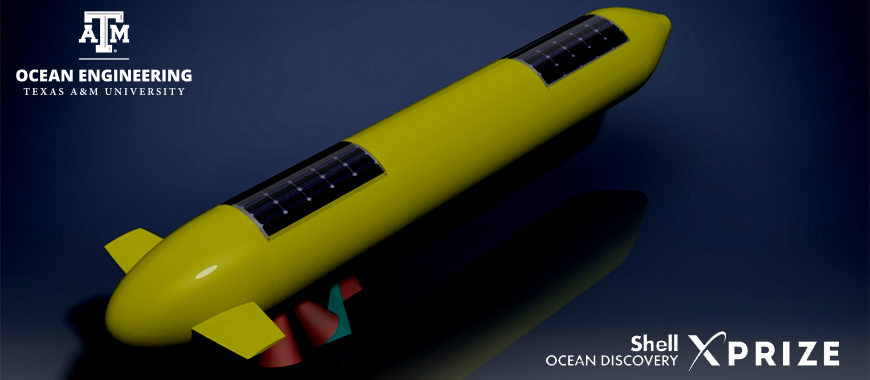
Students in the Department of Ocean Engineering at Texas A&M University were recently announced as a semi-finalist team in the Shell Ocean Discovery XPRIZE competition. The multi-national team, comprised of students and professors, is now one step closer in their pursuit of winning the global competition to advance ocean technologies for rapid, unmanned, and high-resolution ocean exploration and discovery. Another team with ties to Texas A&M, X994 from Austin, also advanced to the testing round.
Both teams are advancing to the competition’s Round 1 testing, where they will test their autonomous underwater vehicles mapping technology down to 2,000-meter depths in the ocean this fall.
Dylan Blakeslee, team leader and senior ocean engineering student, is confident in the work that has been completed thus far and optimistic about the future successes in store for them.
“We have a lot of work to be done between now and September, but we have an amazing team and support from leading companies in the industry, as well as the Texas A&M ocean engineering department,” Blakeslee said. “With the continued support and invaluable advice from Deep Down Inc. CEO Ron Smith and Oceaneering, we will build ‘Marlin,’ a vehicle that will change the way we think about the ocean.”
Dr. Sharath Girimaji, head of the ocean engineering department and holder of the Wofford Cain Chair II, supports involvement in the many experiential learning opportunities available to students outside of the classroom.
“Participation in innovative competitions such as the Shell Ocean Discovery XPRIZE add great value to their educational experience,” Girimaji said. “This really helps our students become book smart as well as street smart.”
Dr. Robert Randall, W.H. Bauer Professor in Dredging Engineering, commended the students on their hard work in designing such technology while collaborating with industry partners.
Mike Ellis, vice president of subsea projects at Oceaneering International LLC, which is sponsoring the team, is impressed with what the team has accomplished.
"Oceaneering is proud to support the Texas A&M ocean engineering team in their pursuit of the Shell Ocean Discovery XPRIZE,” Ellis said. “The challenge of long duration autonomous exploration of our oceans provides the perfect framework for students to apply their knowledge and abilities toward an amazing goal.”
X994, the only other team to advance from Texas, was cofounded by three Texas A&M former students. David Ryan studied biomedical engineering, and his X994 cofounders Matthew Meyer and Ryan Thomas hold master’s degrees from Texas A&M in geological oceanography. X994 is optimizing robotic mapping of the ocean through advancements in software, artificial intelligence and data analytics.
“We are all extremely honored to be a part of such a prestigious competition and at the prospect of unlocking the mystery of the ocean,” Blakeslee said.
The Texas A&M team includes Hunter Adams, Sudikshya Bhandari, Marlon Batistella, Dylan Blakeslee, Aniket Bonde, Luis Cardoso, Mitchell Disbrow, Tucker Folsom, Nathaniel Franklin, Pankaj Goel, Prashant Gundale, Pranjay Gupta, Jessica Heath, Brian Hubbard, Micah Hutcherson, Sambong Jang, Chung-Kuk Jin, Jacob Kennedy, Hansung Kim, Jaewon Kim, Jin-young Kim, Sejin Kim, Susmitha Kotu, Nirup Kumar, Aishwarya Mahadevan, Garrett Malatek, Animesh Mathur, Nabil Moosajee, Chinenye Nwagbara, Zachary Ratliff, Jeevan Reddy, Levi Roady, Vinit Shah, Rahul Sharma, Gabe Tatman, Graciela Villalpando and Kamel Wetie. Charlie Donaway, Ronald Smith, Randall and Girimaji are supervising the team.
The final round of the competition will take place in fall 2018. Up to 10 qualifying teams that proceed to Round 2 will split a $1 million milestone prize purse. A $4 million grand prize and a $1 million second place prize will be awarded to the two teams that receive the top scores for demonstrating the highest resolution seafloor mapping, after meeting all minimum requirements for speed, autonomy and depth. The $1 million National Oceanographic Atmospheric Administration bonus prize will also be awarded to the team that can trace a chemical or biological signal to its source.